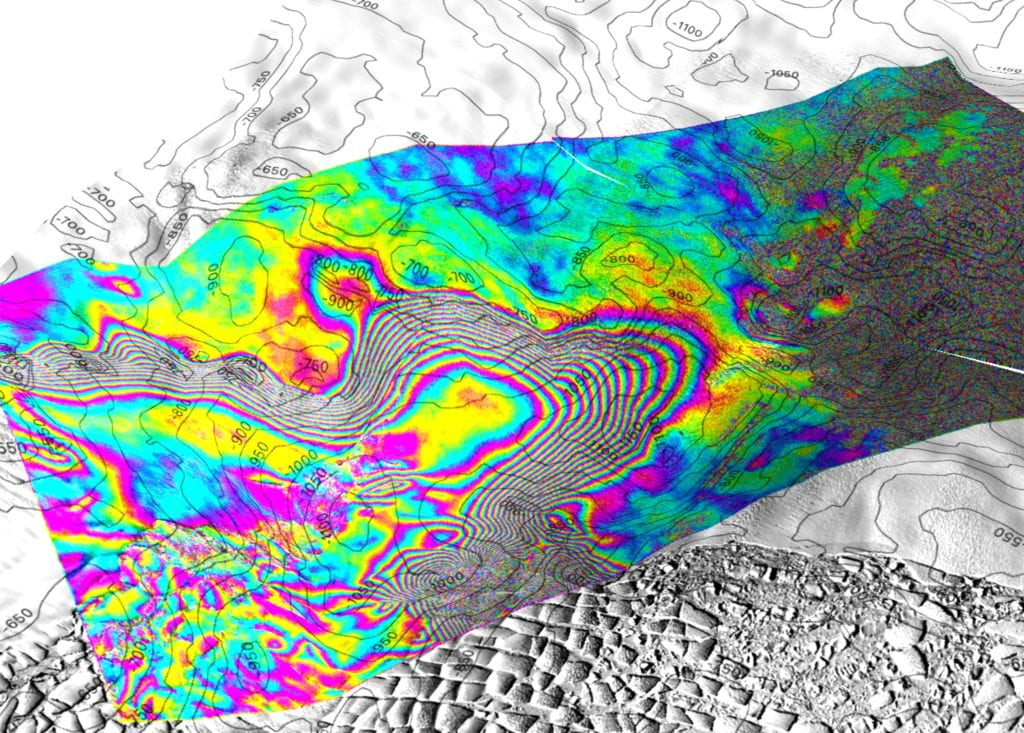Tidal pressures have been observed pushing (relatively) warm water under the Thwaites Glacier, exposing a much larger area of ice to warming pressure. The observations indicate a catastrophic sea level rise could be coming much sooner than almost anyone is preparing for.
Rising temperatures are contributing to higher sea levels by making the existing water in the ocean expand, as well as by melting alpine glaciers and the Greenland ice sheet. All of these are virtually certain to increase, and spell trouble for coastal cities worldwide. There is much more uncertainty, however, about the rate at which Antarctic ice will melt, potentially multiplying existing estimates for flooding threats. Despite the vastness of Antarctica, one glacier, the Thwaites, is considered key, earning the name “The Doomsday Glacier”.
The Thwaites Glacier is 120 kilometers (75 miles) wide where it reaches the ocean and extends from West Antarctica into an offshore basin. The warming of air above and the water in front of the Thwaites are causing it to melt, but there are fears of something much worse. Water underneath the Thwaites where it currently sits upon the bottom of the ocean would expose the ice to much more heating, greatly speeding up the melt rate.
This is where observations by Professor Christine Dow of the University of Waterloo and colleagues come in. They have seen evidence in satellite imagery that the water is getting beneath the glacier daily and lifting it off the seabed, before the weight of the 1.2-kilometer (4,000-foot) thick glacier causes it to settle back down. The cycle repeats with the tides over the front 2-6 kilometers (1.2-3.7 miles) of the glacier, but when Sun and Moon align to create extreme tidal conditions they can reach up to six kilometers further.
This causes brief accelerated warming, but the shape of the basin means that if, or more realistically when, the glacier’s front retreats deeper into the basin the underside melting will become continuous. Two ridges on the seabed are the planet’s last lines of defense against accelerated melting. The question for humanity is how long we have before both are breached.
False coloring of a satellite images shows the flexing experienced by the Thwaites Glacier as tidal pressures rise and fall, as water penetrates for kilometers beneath the ice, accelerating warming.
Image credit: ICEYE; ERIC RIGNOT / UC IRVINE
Dow and co-authors estimate this will occur in 10-20 years’ time, and with it will come a greatly accelerated rise in sea level. “Thwaites is the most unstable place in the Antarctic and contains the equivalent of 60 centimetres [24 inches] of sea level rise,” Dow said in a statement. “The worry is that we are underestimating the speed that the glacier is changing, which would be devastating for coastal communities around the world.”
The wealthiest locations might install dykes like the Netherlands or tidal barrier like London, but for much of the world this will mean the drowning of homes and prime agricultural land.
Dow is hoping to achieve more precision on how soon we can expect to see these events occur by refining models of the way water flows in and out of the basin, and how saltwater and glacial melt mix there. “At the moment we don’t have enough information to say one way or the other how much time there is before the ocean water intrusion is irreversible,” she said.
However, modeling can only take one so far without direct observations to calibrate it. Scientific data from Antarctica once advanced at a pace comparable to the one at which glaciers moved. Eyes in space have turned some aspects into a flood, but the same isn’t true for operations that require boots on the ground.
“We operate at the same budget in 2024 in real dollars that we were in the 1990s,” said lead author Professor Eric Rignot of the University of California, Irvine. “We need to grow the community of glaciologists and physical oceanographers to address these observation issues sooner rather than later, but right now we’re trying to climb Everest in tennis shoes.”
The study is published open access in Proceedings of the National Academy of Sciences.
Source Link: Warm Seawater Is Flowing Under The “Doomsday Glacier” And It’s As Bad As It Sounds
